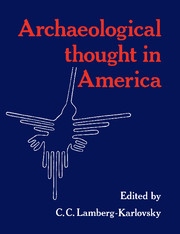Book contents
- Frontmatter
- Contents
- List of illustrations
- Introduction
- Part I History, method, and theory
- 1 History and contemporary American archaeology: a critical analysis
- 2 Aspects of the application of evolutionary theory in archaeology
- 3 The “New Archaeology,” then and now
- 4 Marxism in American archaeology
- 5 Formal approaches in archaeology
- 6 Ideology and evolutionism in American archaeology: looking beyond the economic base
- 7 The present and the future of hunter-gatherer studies
- 8 Paleopathology and the interpretation of economic change in prehistory
- Part II Archaeology in the Americas and beyond
- References
- Index
1 - History and contemporary American archaeology: a critical analysis
Published online by Cambridge University Press: 06 July 2010
- Frontmatter
- Contents
- List of illustrations
- Introduction
- Part I History, method, and theory
- 1 History and contemporary American archaeology: a critical analysis
- 2 Aspects of the application of evolutionary theory in archaeology
- 3 The “New Archaeology,” then and now
- 4 Marxism in American archaeology
- 5 Formal approaches in archaeology
- 6 Ideology and evolutionism in American archaeology: looking beyond the economic base
- 7 The present and the future of hunter-gatherer studies
- 8 Paleopathology and the interpretation of economic change in prehistory
- Part II Archaeology in the Americas and beyond
- References
- Index
Summary
Extraordinary as it may seem to those who have been trained in the Western European and Soviet traditions of archaeological research, history, both as a discipline and as a methodology, has always been viewed as largely irrelevant to prehistoric archaeology in the United States. Prehistoric archaeologists have recognized only a narrow thematic overlap between their discipline, which as a branch of anthropology examines the prehistoric remains of American Indians, and history, which studies the actions of Europeans and Euro-Americans (Fitzhugh 1985). Nor have prehistoric archaeologists seen historiographical methods as having any special relevance for their work. Prehistoric archaeology has been characterized by dramatic oscillations between evolutionary and anti-evolutionary perspectives and by a general failure to recognize that history and evolution are complementary rather than antithetical concepts. The reasons for this are to be found in archaeology's relations to Euro-American society and its values. A brief examination of the history of these relations is therefore necessary to understand recent developments. The connection is of particular interest because for the most part until recently it has been an unselfconscious one.
One of the important factors affecting this relationship has been the low prestige accorded to history in the United States during the twentieth century; an attitude epitomized by the remark of the industrialist Henry Ford that “History is bunk.” Commentators have noted the “present-mindedness” of American culture, which they associate with the belief of Americans that they have freed themselves from the legacy of their European past (Kroker 1984:8).
- Type
- Chapter
- Information
- Archaeological Thought in America , pp. 19 - 34Publisher: Cambridge University PressPrint publication year: 1989
- 8
- Cited by



